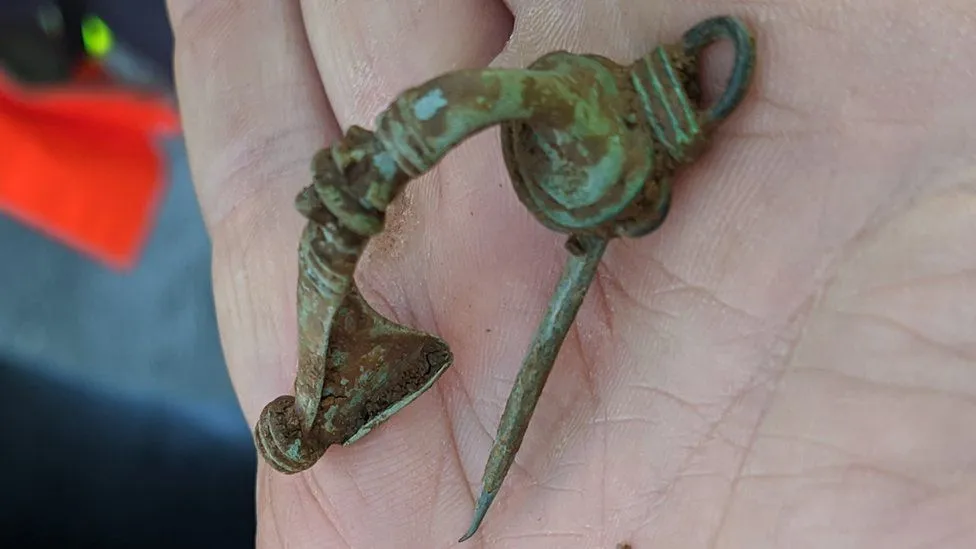2,000-Year-Old Figurine of Roman Love God Cupid Found in England
Archaeologists say the petite statue, discovered ahead of construction of highway, may have been a religious offering
:focal(396x228:397x229)/https://tf-cmsv2-smithsonianmag-media.s3.amazonaws.com/filer/46/3d/463d428e-22b2-499b-8a40-3e4024785719/cupid.jpg)
Archaeologists in southwestern England have discovered a nearly 2,000-year-old figurine of the god Cupid along the route of a former Roman road.
As Matty Airey reports for the Gloucestershire Gazette, a Highways England team surveying the area ahead of construction discovered the statuette, as well as a bow-shaped brooch and a human skeleton, outside the town of Birdlip in Gloucestershire County.
“It is a rare and exciting find,” says Mel Barge, inspector of ancient monuments at Historic England, in a statement. “It will tell us about the lives and beliefs of the small Roman community that lived alongside this road.”
Per BBC News, fewer than 50 Roman Cupid figurines have been found in the United Kingdom to date. This one is made of solid bronze and shows the winged god of love holding a flaming torch. The statue was unearthed in a charcoal deposit, suggesting it may have been an offering to the gods.
In a separate statement, Highways England notes that worshippers may have left the petite deity in a roadside temple—a common feature in Roman-era England.
Cupid, the Roman version of the Greek god Eros, is known for shooting arrows that cause their targets to fall in love (or lust). Today’s Valentine’s Day cards depict him as a chubby-cheeked winged baby, but as Alice Abler wrote for Vision in 2010, the god was often shown in ancient times as an older boy or young man. He, and his mother, Venus, were associated with Lupercalia, the ancient Roman festival of purification, health and fertility.
Given its ornate crafting, the brooch found at the Gloucestershire site was likely worn by a wealthy owner. It would have been used to fasten a cloak against the wind.

The skeleton buried alongside the artifacts proved to be more enigmatic. Though Christian tradition dictates that burials should face east to west, this grave was oriented north to south. The researchers theorize that the individual may have been a Roman buried before the fourth century or an early Saxon from between the fifth and seventh centuries.
Adding to the mystery is the fact that the body was buried facedown, which might have been a sign of disrespect for a criminal or someone otherwise disliked by their local community. The skeleton will be reinterred rather than removed for further research.
The archaeological work is part of the A417 “missing link” project, a planned 3.4-mile connection between the A417 highway and a bypass road. The existing highway is built along the path of a former Roman road; researchers have previously found the remains of villas and temples from the Roman period in the area, as well as settlements dating back to the Neolithic period.
According to Claire Hayhurst of PA Media, the team studied historical records and conducted geophysical surveys to identify likely places for excavations. The archaeologists are not disclosing the precise location of the new finds, but Highways England tells PA that it was on privately owned land close to the planned construction route.
The excavation is one of a number of archaeological projects organized by Highways England in conjunction with its road-building work. Elsewhere in England, the government-owned company has uncovered evidence of early Roman settlements, mammoth tusks, ancient breweries and pothole repairs from the Roman period. Some of its archaeological work has come ahead of construction of a controversial tunnel near Stonehenge, as Gwyn Topham and Steve Morris reported for the Guardian last November.
“It has been fascinating to reveal more about the area and the people who once lived here,” says Jim Keyte, the project’s archaeology lead, in the statement. “Our investigations will continue as the project progresses, and we expect more interesting discoveries to come.”
/https://tf-cmsv2-smithsonianmag-media.s3.amazonaws.com/accounts/headshot/Livia_lg_thumbnail.png)
/https://tf-cmsv2-smithsonianmag-media.s3.amazonaws.com/accounts/headshot/Livia_lg_thumbnail.png)